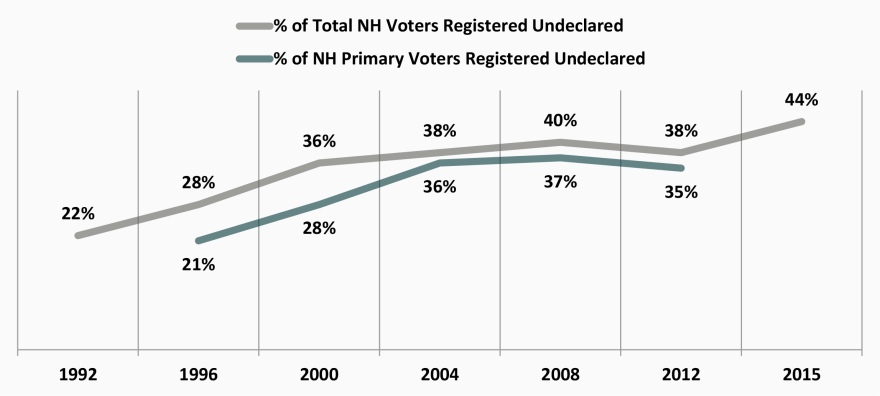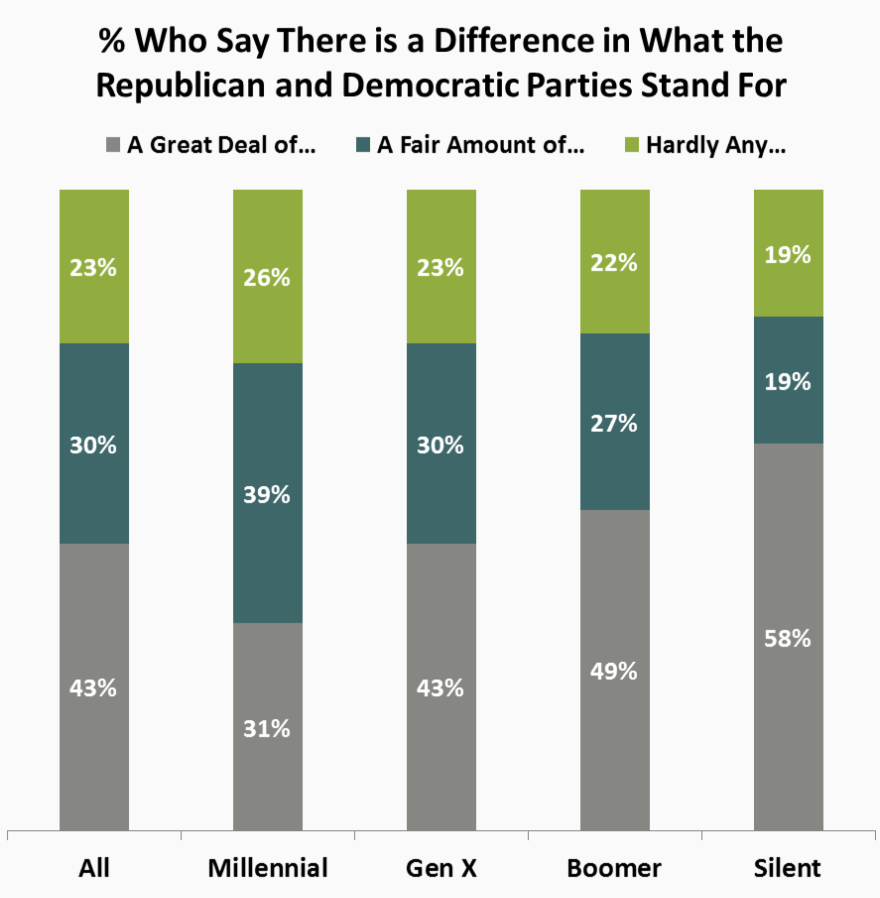New Hampshire’s independent streak is wider than ever and still growing. And that could make predicting the outcome of the 2016 presidential primary tougher than usual.
In political terms, increasing numbers of New Hampshire voters are showing their independence by declining to register with either major party. There are more of these “undeclared” voters in New Hampshire today than in any previous election cycle, and they are playing a bigger role in the state's primary elections.
Because New Hampshire allows undeclared voters to participate in the party primary of their choosing, they add a dose of uncertainty to each party’s contest. And when they do cast a ballot, recent history shows independent voters choose different candidates than party loyalists in either contest.
New Hampshire Has More Undeclared Voters Than Ever

Let’s take a look at the numbers. Since 1992 the number of undeclared voters has more than doubled in New Hampshire, while the total number registered with a major party has climbed less than 10 percent. Today, 44 percent of registered New Hampshire voters are unaffiliated with a political party, the highest share ever, and that number is likely to climb.
These undeclared voters aren't content to sit on the sidelines on Primary Day, and their presence is slowly but surely reshaping presidential primary contests. In 1996, just 21 percent of Primary Day voters were undeclared. Over the last few election cycles, this figure has jumped to between 35 percent and 37 percent overall. And in the most competitive contests within each party’s primary, the share of undeclared voters has been higher than 40 percent.
Undeclared Voters Are Playing A Larger Role in N.H. Primaries
Chart 1: Undeclared voters and undeclared N.H. Primary voters are on the rise

Chart 2: Undeclared voter participation in party primaries varies greatly based on political climate

This trend shows no signs of reversing. If anything, the influence of undeclared voters in all aspects of New Hampshire politics may grow even stronger as demographic trends take hold. Compared to other age groups, young people in New Hampshire are less likely to register with either political party. Just over half of voters under 30 are undeclared, a percentage that's nearly twice as high as for the state’s oldest voters.
New Hampshire's Undeclared Voter Roles Will Continue to Grow

As today’s young people become a larger share of the state’s electorate, the share of undeclared voters is likely to grow. This pattern is not unique to New Hampshire, but it does matter more here than elsewhere, given the importance of the state’s undeclared voters in the first-in-the-nation presidential primary.
In theory, tomorrow’s younger voters could prove to be more partisan, but there's no evidence this is on the horizon. The Pew Research Center has tracked party affiliation by generation for decades. Their research shows, at most, a very slight trend toward party affiliation as voters age, but not nearly enough to stem the tide of independents washing upward on the state’s population pyramid.
Younger people are also least likely to see a major difference between the two parties, and they are the most likely of any generation to consider themselves political independents.

Even if New Hampshire’s younger population continues to decline, this trend will continue as each age group proves more independent than the one before it. In other words, today’s 70-year-old is more likely to be undeclared than today’s 80-year-old. This is a trend accelerated by young people, but it’s not exclusive to young people.
Whatever happens in the future, today’s undeclared voters introduce the potential for volatility in New Hampshire right up through February's first-in-the-nation contest. That’s because they can change their mind as to which party election to vote in, even as they walk into their polling place.
For instance, if the Donald Trump wave continues and the Republican side does not appear competitive, undeclared voters may choose the Democratic primary rather than “waste” their ballots on what appears to be a foregone conclusion. If both races are competitive, as was the case in 2008, undeclared turnout could soar on both sides.
All of this poses problems for pollsters, given that a large slice of voters polled this week for the Republican contest may opt for the Democratic side next week, and flip back to the GOP the week after. Research shows that New Hampshire's undeclared voters do indeed change their plans for which primary they will choose. In 2000, for instance, some undeclared voters who initially said they planned to vote in the Democratic primary changed their mind and voted on the GOP side, boosting Arizona Sen. John McCain in the Republican contest. He would go on to win, based largely on his margin among independent voters.
The lack of a publicly available state voter file means we don’t have great data on the extent of switching primaries between elections. But looking at the drastic differences in turnout from election to election shows it is not just the same old group of disguised partisans who make up the undeclared voter group each election cycle.
McCain's 2000 victory is not the only time independent voters took a different route than partisan voters. Most pre-election polls and exit polls focus on which party voters identify with most closely rather than how they are actually registered. This makes assessing the impact of undeclared participation somewhat imprecise. But there is considerable overlap between registration and self-identification, and the differences in candidate preference are often considerable, meaning we can use party ID as a rough approximation for party registration in this case.

In 2008, for example, Barack Obama pulled more support from independent voters, while Hillary Clinton rode Democratic support to a surprise upset, according to exit polls. On the Republican side that year, it was just the opposite, with John McCain again winning with a lopsided margin among independent voters. In 2012, Mitt Romney tied with Ron Paul among independents but won the primary easily because of his 34-point margin among registered Republicans.
History shows this trend over and over again. Independent voters do not vote like partisans. Historically, the candidate with the highest level of support from partisans wins the primary. But with the share of undeclared voters at an all-time high and rising, we are nearing the day when the whims of the undeclared voters may prove decisive.
Steve Koczela, president of The MassINC Polling Group, writes for NHPR about the role polling and public opinion research are playing in the 2016 New Hampshire presidential primary. He tweets at @skoczela.







